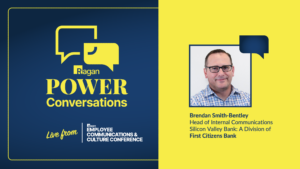Listening, values and the psychology of internal comms
Staffbase’s VOICES conference featured panels and presentations from some of the top figures in internal comms.

Among trending conversations in our field about the future of communications, the rise of generative AI and ways to make internal comms resonate with the right audiences, a human thread links everything together— internal communicators can bring a level of humanity to your organization that has a substantial impact on the growth and health of your people.
“Communication moves people, and people move companies,” Staffbase CEO Martin Bohringer told the audience at Staffbase’s 2023 VOICES conference in New York City last week. Throughout the day, presenters spoke of the mindset behind successful internal communicators and how to tell an organization’s authentic story. After a long day of insight sharing, the conference was capped with some thoughts from esteemed journalist Soledad O’Brien.
The psychology of internal comms
At the outset of her presentation, social psychologist Amy Cuddy posed a question to the audience.
“What’s your biggest communication challenge?” she asked.
The audience responded that many challenges result from letting employees and receiving other types of negative feedback. While these aren’t easy conversations to have, Cuddy acknowledged that communication undertaken with anxiety or dread is destined for failure.
“Executing tough conversations with anxiety and regret will prevent you from hearing what’s actually happening in the conversation,” she said. “People have a hard time accepting outcomes when they don’t feel seen. If they do feel seen, it’s easier for them to accept a negative outcome and move forward. That can be achieved by a change in approach.”
Cuddy suggested that communicators use “approach” methods of communication that focus on cultivating trust rather than “inhibition methods” that frame communications as a threat rather than a bridge-building opportunity.
“We should aim to see challenges not as threats but as opportunities,” she added. “We can grow and learn about our abilities and of those around us through trusting communication. We should aim to view others not as competitors, but as collaborators instead.”
In an era when distrust and confusion are the topics of the day, added Cuddy, employees still trust their employers. That provides an opportunity for better communication.
“Creating great communication is both a challenge and an opportunity — but we can re-empower our employees by first re-empowering ourselves and the way we look at our communication,” she said.
Telling your organization’s story through its values
Later in the day, a large group gathered to hear Ann Mellinger, CEO of Brilliant Ink, espousing the importance of communicating your organization’s values along every step of the employee journey.
“Communicators serve as a mirror to show us what our values actually are,” she said. “They are great at espousing values because they’re storytellers.”
Mellinger also shared the importance of celebrating a company’s cultural values frequently to drive them home as part of internal messaging.
“Every company’s leaders should be highlighting stories that focus on the values of their organization,” she said. “Storytellers can help show what it really means to live those values every day to build a strong culture.”
Soledad O’Brien on the power of listening
The day concluded with a packed auditorium listening to the stories and advice of award-winning journalist Soledad O’Brien. The conversation was wide-ranging, but O’Brien placed a special focus on the power of listening within communications. She shared that her decades of work as a journalist helped her gain a nuanced perspective on listening to her interview subjects.
“There’s a mythology that reporters should be robots,” said O’Brien. “That’s wrong. I’ve felt that emotion and compassion is a really good thing,” O’Brien said.
The key to increased understanding in communications, she went on to say, is rooted in proper listening skills.
“I think (when you actively listen) you quickly begin to understand people better, and that can help you transmit what they’re telling you to the audience.”
O’Brien concluded the event by answering an audience question about how to best provide the perspectives of those who might not have their voices amplified.
“Give the audience points of view they may not have heard before,” she said. “Make sure you have the right people around the table. The only way to get new perspectives from the right people is to turn over the power to them.”
Sean Devlin is an editor at Ragan Communications. In his spare time he enjoys Philly sports, a good pint and ’90s trivia night.







